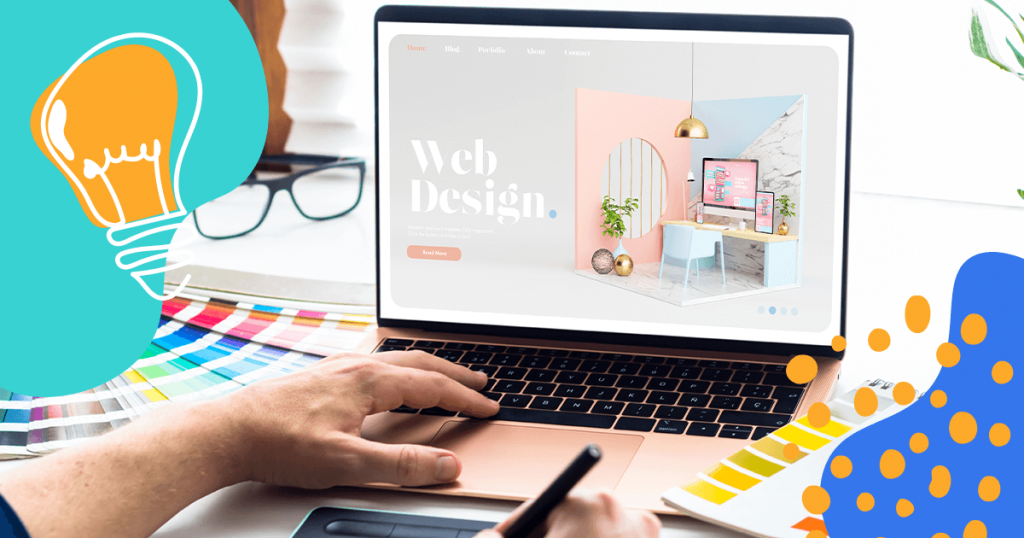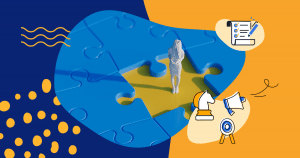With everyone and everything online these days, it’s a top priority to ensure your brand’s digital presence is the best it can be.
At the center of that online presence, of course, is your website. Time spent creating, updating, and maintaining your web content will be beneficial both to you and your customers.
But what if you aren’t familiar with web design and how to go about it the right way? You may doubt your own skills and feel paralyzed when deciding how to move forward.
Web design doesn’t have to be a struggle or an endless endeavor. Sure, you will want to continue updating it after creation, but if you start with the basics, you can gain the confidence needed to keep moving forward and maintain a website that shines.
To help you build those skills and that confidence, we’ve provided you with the information you need to get started and excel from there.
Download this post by entering your email below
What Is Web Design?
Web design is the field that involves digital interfaces such as websites, apps, and services.
By using HTML code to program websites and CSS to standardize its visual language, web design professionals are responsible for building digital experiences to be used by the public. The aim is to deliver a quality experience to the audience and help the business reach its goals.
As such, a web designer is a professional that acquires the necessary skills to perform this job. Those might be specialized in specific web design fields, ranging from website creation to mobile app development. In all cases, the goal is the same: to materialize the project’s vision.
Web design has a few subdivisions that are detailed below.
Web graphic design
This is web design applied to a website’s visuals. It involves everything from the colors and fonts to the general layout of its pages.
The most important task is translating the brand’s identity into the website’s design. The visitor must be able to relate to that and properly see the page as part of that business’s presence.
Interface design
Web design work also refers to interface design. Not only does it apply to traditional websites but it involves mobile apps, games, computer software, and several other products too. After all, an interface is anything that serves as an intermediary between the user and the system.
The idea is to deliver an interface that is simple, intuitive and adapted to the target audience’s particularities.
User experience design
The look and feel of a digital interface also require a good user experience. Otherwise, your audience will seek other solutions.
A web design professional is tasked with creating a truly worthwhile experience, which means understanding your user’s needs and delivering on them. Interacting with your business should always be a positive moment for its audience, which means having no barriers and always achieving its goals.
Search engine optimization
Last but not least, web design also involves working with search engine optimization (SEO) to make sure that Google and similar sites properly index your content. This helps your content reach better positions on the search results ranking, thus reaching a wider audience that is looking for your solution.
Even though some aspects of SEO are related to content writing, web design also plays a role in making sure your website’s code is clean and that usability does not hinder your experience. All of those factors are decisive in determining your ranking position.
Why Does Web Design Matter?
Web design is the tool you use to help people perceive your brand how you want them to. By applying the correct visual marketing strategy and approach, your business will be able to attract the right audience and convert them into customers — see some landing page design examples.
By having contact with a brand that offers consistency and projects trust, users feel more inclined to do business with it. Without a clear web design plan, you lose the potential results that a good online presence can give you.
As such, it is not an element of your project that should be neglected. Your audience will be able to tell your design is lacking and will not want to engage with your business through this terrible experience. Instead, they will choose competitors that give appropriate value to web design.
That is also why it is important to work with qualified web designers. A skilled professional can analyze what your brand needs and use the right tools to translate it visually while staying true to its strategy and goals.
5 Key Design Principles For Website Building
As a brand owner, marketer, or department manager, you already know the importance of providing the right content and the best visual aids to attract and retain a target audience. Now you just need to make sure your website has them. Below are a few of the most important principles of web design to help you start out on the right track.
Connect your website design to your targeted audience
Before even beginning the creation of your website or revising what you already have, define your target audience. Knowing this will help you connect your website design directly to your intended audience and create a better customer experience.
The goal is to only use visual elements and content that will appeal to the desired visitors. Conduct research to find out who they are, how they prefer to learn about products or services, their buying behaviors, what they dislike, and other details. If you have already created buyer personas, expand as much as possible on them so that you have the information you need to tailor your website to them in particular.
You want the right visitors to reach your website and, once there, feel at home. When this happens, they spend time getting to know you and are more likely to take action.
Avoid Overcrowding and Clutter
When a visitor arrives at your website, it only takes seconds for them to decide whether to stay or not. An overwhelming layout full of images, fonts, colors, buttons, and other elements can be a deterrent that causes them to look elsewhere for what they need. This means you lose the potential for conversions and gaining loyal customers.
Instead, wisely choose what you want to place on each webpage. Break up text with high-quality images and well-positioned white space. Make it aesthetically pleasing, from the headlines and visual elements to the font and overall layout.
Here are some tips that may help:
- Consider the visitor experience first and foremost, and keep it simple.
- Select the colors that will be used consistently throughout your website.
- Choose typography that will match your brand voice.
- Identify the best image forms to use, such as infographics, videos, animations, illustrations, and photography.
Never forget the importance of high-quality content
While visual elements can attract the eye of a visitor, high-quality content is what will keep people on the page longer.
Your content is how you connect with customers, providing them with what they are looking for and what they need. If written well and strategically positioned on the page, it can help the customer advance along the buyer’s journey and graduate to the next level.
Within this content, provide both internal and external links where appropriate, and always include clear calls to action.
Make navigation simple and easy
While you can get caught up in the design of a webpage, you also need to consider the visitors’ ability to navigate your site.
A common complaint of website visitors is that they are unable to locate the content they want or need. The last thing they want to have to do is search for it. Instead, make it easy for them. Ways to accomplish this include:
- Create tabs at the top of a webpage to show visitors the different sections available on the site.
- Use left or right-side menus that list the website’s sections.
- Add a search feature if your website is large. This will help visitors find what they want faster.
- Include links at the bottom of the webpage.
Incorporate an SEO plan
Optimize your website design for search engines. You want search engines to be able to find your web pages and index them. Otherwise, your pages won’t appear on any SERPs.
Start with keyword research, and use those words or phrases in your titles, meta tags, headlines, and the body of your content.
What To Consider When Designing a Website?
As you have already seen, web design can be a part of a powerful business presentation. However, making the wrong choices can have a negative impact on your entire online presence.
Certain factors must be considered when designing a website to guarantee its quality. Below are the most important ones.
Aesthetics
Whenever people discuss web design, this is the factor most thought of. Though, it is not the only one that is important.
Your brand’s identity dictates your website’s aesthetics and it must be well-condensed by your web design. This means making sure your online presence matches your colors, styles, and feel. Be careful not to exaggerate, as too many elements might bog down your visitor’s experience.
Usability
Never forget real people will use your website, so its web design needs to have good usability. However, what does that entail?
Usability means being able to be browsed by an audience of multiple backgrounds, ages, and specialties. Simplicity is one of its most important principles, which requires you to strip down your number of menus and options.
Put yourself in your visitor’s shoes and think of what they would consider intuitive.
Content quality
Even if all the other web design elements work well, they are nothing without good content. On the contrary, why would your visitors even come to you?
That is why so many businesses choose Content Marketing so that they always have quality content that people will want to read and share. This job requires making sure your pages add value to your visitor’s time by offering the right solutions.
Speed
Did you know that people might give up on your business if your website does not load quickly? Studies have shown that, if your page load time surpasses 3 seconds, your bounce rate tends to rise by 38%. This is bad.
Another factor in web design relates to load speed. This involves finding a balance between all your elements and the strain they take on your visitor’s browser and internet connection.
Mobile-friendliness
According to the latest data, mobile devices account for over 50% of all online traffic. This means that, if your website does not load correctly on smartphones and tablets, you might be scaring off roughly half of your potential audience!
In order to avoid that, your web design strategy should make sure that your content is mobile-friendly. This means having pages that load and adapts appropriately to multiple screen sizes and access conditions.
What Are The Worst Web Design Mistakes?
Since web design is an important part of your digital marketing strategy, you want to ensure that your brand is well-represented and you provide your target audience with a quality experience.
Before getting started on your web design, however, it helps to know what mistakes to avoid. You can keep them in mind as you move forward to prevent yourself from having to go back and make corrections after your site goes live.
Some of the worst web design mistakes include the following:
Failing to consider your target audience
While some websites might look amazing, their owners may wonder why they are failing to get the response they expected. Perhaps it is because they neglected to design for their target audience.
Your website needs to speak directly to your ideal customers. What they see and the overall user experience on your website will be the main drivers for interaction, satisfaction, and sales.
By not considering your target audience as you plan and execute the website design, you could greatly reduce your brand’s ability to attract high-quality visitors who are likely to convert.
One industry that often gets this right is car manufacturing. For example, Subaru caters to a particular segment of the population, while Audi uses its website to attract a different group. Each brand clearly knows its target market and applies that knowledge to its web content and design.
Inconsistent visuals across channels
An error that many brands make involves forgetting to keep visuals consistent across the many different marketing channels they use. This can happen for various reasons, such as not having a brand style guide for their employees or failing to fully establish a brand personality before developing a design.
The essential reason for maintaining consistent visuals is that they make your brand instantly recognizable when potential customers see it on your website, social media accounts, and wherever else you focus your marketing efforts.
You want to create cohesiveness in your signature designs, showing the personality of your brand or company and sharing it everywhere you go. Your website needs to be the hub of your brand, and everything branches out from there.
Excessive elements
Overcrowding your web design with too many elements may distract users and weaken the digital presence of your brand. Visitors can quickly become overwhelmed and leave your site before they learn about your brand, products, or services.
Several sites online today suffer from having too many elements that compete for the eyes of visitors. While it is understandable that you and your team want to share your creativity, remember that clarity and readability will be key to the user experience.
Lacking a clear CTA
One of the most damaging mistakes web designers make today is not providing a clear call-to-action (CTA). This statement lets viewers know what you want them to do next.
The result is a failure to direct potential customers onward to the next stage in their buyer’s journey. For you, it means fewer conversions and sales.
CTAs need to be clear and concise, such as “Click here to learn more” or “Order Now.” There also needs to be clear information surrounding the CTA that explains what the customer can expect when they do take that action.
Failing to document web design decisions for future use
During the web design process, it is essential to document design decisions and how you came to them. Why? Because, in the future, you may need to make changes to your site but be unable to remember why you did or did not do something earlier.
Perhaps you evaluated your target audience and the brand personality you wanted to convey before choosing particular elements to include. You may later want to know why you came to these conclusions.
Without documented reasons for the decisions you made, you might either clutter your site with changes that are inconsistent with what your customers expect or have to spend an inordinate amount of time trying to recreate your site altogether.
5 Most Popular Web Design Tools
When it comes time to create your website, outsourcing may be the best choice, saving you time and potential frustration. However, if you decide to give it a try on your own, there are several web design tools available to make it easier.
Consider the following popular web design tools that are currently being used by individuals, small businesses, companies, and brands of all types and sizes.
WordPress
WordPress is a well-known tool for building websites and blogs, and it’s one of the best design tools for beginners. The features include custom content types, integrated blog and news posting, and even augmented reality when you are ready for it.
This inexpensive option is user-friendly, easy to start using, and allows you to build whatever type of website you want. You may choose to go with pre-designed layouts, themes, and plug-ins, or spend more time coming up with a custom design of your own. You can start designing right away before even purchasing a domain name or hosting service.
Wix
Another way to easily build your website is with Wix. This all-in-one online tool offers free templates and also provides web hosting options. Thanks to an easy-to-navigate dashboard and intuitive tools that help you get off to a quick start, beginners won’t feel overwhelmed.
Websites come out looking professional and easy to manage. Wix also assists with adapting your website for mobile users.
Adobe
You are most likely already familiar with Adobe, possibly because you have used Photoshop, Illustrator, or one of the other options in their Creative Suite.
Now you can also use Adobe XD, their vector-based website design tool, which can work directly with Photoshop and Illustrator. All you have to do is simply transfer your designs from these programs to XD.
Adobe XD provides you with access to a design asset library full of colors, fonts, and other essential components that help make your website stand out.
Canva
When building a simple website, Canva may be all you need to get started. Use it to create webpages, blog entries, articles, social media posts, and more. You will have access to numerous graphic categories and templates, training and educational videos, and a user-friendly interface.
You can also benefit from the basic analytics provided under its Canva Insights feature. For example, keep track of customer engagement to learn what web pages are drawing the most attention and where improvements might be warranted.
Sketch
Sketch is a web design tool that allows you to drag and drop, making it one of the simplest options on this list. You can design beautiful websites and blogs without pulling out your hair in the process.
It also offers an app library full of plug-ins, assistants, and apps to help you take your website design up a notch when you’re ready.
Hiring a Web Designer: Must-Have Skills to Look For
Considering the importance of web design, it is clear that the professional that plans and executes it needs to have certain skills to bring quality to their work. Otherwise, the entire project might be hindered and unable to reach its goals.
Below are the most importantly soft and hard skills a web designer must-have.
HTML/CSS
Programming knowledge is required to work on web design. The main necessary languages are HTML and CSS, with each one performing a different job.
HTML (Hypertext Markup Language) and CSS (Cascading Style Sheets) coordinate how elements are displayed on web pages. A skilled web designer is able to accurately apply the planned design by using the right tags and values when writing in HTML and CSS.
UX/UI
Since web designers work with interfaces, they must be skilled at UX/UI. Despite being commonly used in conjunction, those are different concepts.
UX design involves work related to user experience. It means tying everything together design-wise to make sure your target audience is satisfied with whatever it is you are creating, whether it is a website, an app, and so on.
UI design refers to work on user interfaces. Designers must be skilled at creating structures that are easily understood so people can achieve whatever tasks they need when using your product or service.
Knowledge of web design tools
Plenty of web design work is done through special tools that streamline and standardize tasks. Knowing your way around them is essential to delivering quality and speed when working in this field.
The first step involves learning what the job requires so you can pick the right tools. There are several alternatives available with varying capabilities, ranging from Photoshop to Dreamweaver.
There are also specialty tools that focus on specific tasks, such as Sketch, which focuses on vector UI elements, and InVision, which helps you present your web design work to a client or superior.
It might sound overwhelming, especially if you are a beginner, but the good news is that all web design knowledge might be acquired via online learning — all you need is a laptop and a desire to acquire new skills
Good communication
A web designer often works in close conjunction with other professionals, so good communication is essential for any project to be completed.
This involves the correct understanding of its criteria and being able to be understood by others.
Being a good communicator is valuable in any field. People who work in web design are responsible for a business’s visual presentation, thus they need to be able to explain how their decisions satisfy the project’s goals and particularities.
Search Engine Optimization (SEO)
Good web design is also able to make sure the content is indexed appropriately by search engines and provides good visibility to its business. That is why designers need to have a grasp of SEO when working in this field.
After all, most assets on a website factor in its ranking, which is something that applies to text, images, and code. This also requires knowledge of how content management systems work and can be optimized.
Good time management
Another soft skill that is highly important for web design is time management. It means finding ways to achieve your goals within specifications while under the project’s schedule.
This is valuable as it can be quite damaging for a business to have its staff spending an inappropriate amount of time on tasks.
Each stage needs to have projected hours considering the budget and deadline. Thus, web designers need to be able to work around that.
Wrap-Up
A website is the hub of your brand. It is where you share your purpose, vision, and so much more.
Whether you build it yourself with the help of online tools or outsource it to freelance professionals, it needs to represent your brand and speak directly to your customers.
If you need help designing your website or just don’t have enough time to do it right, WriterAccess web design services can help. Begin a 14-day WriterAccess trial to get a feel for how it works and see how fast it is to create the ideal website for your business.








